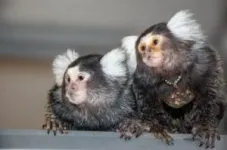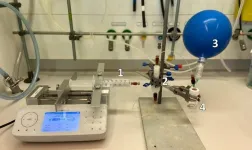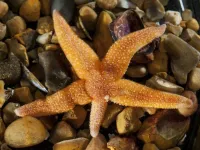(Press-News.org) New study from Hebrew University reveals that marmoset monkeys use specific calls, known as "phee-calls," to name each other, a behavior previously known to exist only in humans, dolphins, and elephants. This discovery highlights the complexity of social communication in marmosets and suggests that their ability to vocally label each other may provide valuable insights into the evolution of human language.
LINK to pictures https://drive.google.com/drive/folders/1VjzO-70hk27UVX_IuQ6FTsHgmCgk9PCH?usp=drive_link
Credit for pictures and sound: David Omer Lab
In a groundbreaking discovery, researchers from Hebrew University have found that marmoset monkeys use specific vocal calls, called "phee-calls," to identify and communicate with each other. This ability to vocally label others has only been seen in humans, dolphins, and elephants until now.
Naming of others is a highly advanced cognitive ability observed in social animals and, until recently, was known to exist only in humans, dolphins, and elephants. Interestingly, our closest evolutionary relatives, nonhuman primates, appeared to lack this ability altogether.
In a new study published today in Science, a team of researchers from the Hebrew University, led by Dr. David Omer from the Safra Center for Brain Sciences (ELSC), made a groundbreaking discovery: for the first time, they found that marmoset monkeys use specific calls, called "phee-calls", to name each other.
To uncover this, the researchers, led by graduate student Guy Oren, recorded natural conversations between pairs of marmosets, as well as interactions between monkeys and a computer system. They found that these monkeys use their “phee-calls” to address specific individuals. Even more interestingly, the marmosets could discern when a call was directed at them and responded more accurately when it was.
“This discovery highlight the complexity of social communication among marmosets,” explains Omer. “These calls are not just used for self-localization, as previously thought— marmosets use these specific calls to label and address specific individuals”.
The study also revealed that family members within a marmoset group use similar vocal labels to address different individuals and employ similar sound features to code different names, resembling the use if names and dialects in humans. This learning appears to occur even among adult marmosets who are not related by blood, suggesting that they learn both vocal labels and dialect from other members of their family group.
The researchers believe that this vocal labeling may have evolved to help marmosets stay connected in their dense rainforest habitat, where visibility is often limited. By using these calls, they can maintain their social bonds and keep the group cohesive.
“Marmosets live in small monogamous family groups and take care of their young together, much like humans do,” says Omer. “These similarities suggest that they faced comparable evolutionary social challenges to our early pre-linguistic ancestors, which might have led them to develop similar communicating methods.”
This research provide new insights into how social communication and human language might have evolved. The ability of marmosets to label each other with specific calls suggests they have developed complex brain mechanisms, potentially analogous to those that eventually gave rise to language in humans.
The study opens up exciting avenues for further research into how our own communication abilities may have evolved and what we can learn from these social nonhuman primates.
END
Uncovering the secret communication of monkeys: They have names!
2024-08-29
ELSE PRESS RELEASES FROM THIS DATE:
Smart mask monitors breath for signs of health
2024-08-29
Personalized wearable devices that monitor people's health are on the rise. From watches to patches and other types of sensors, these smart devices can monitor heart activity, inflammation levels, and more to help patients better manage their health from their own homes. Now, a new type of wearable device can be added to the list: a high-tech paper mask that monitors one's breath.
Caltech's Wei Gao, professor of medical engineering, and his colleagues have developed a ...
Mechanisms of how morphine relieves pain mapped out
2024-08-29
In a study published in Science, researchers at Karolinska Institutet describe the neural processes behind how morphine relieves pain. This is valuable knowledge because the drug has such serious side effects.
Morphine is a powerful painkiller that belongs to the group of opioids. It blocks signals in the pain pathways and also increases feelings of pleasure.
Morphine acts on several central and peripheral pain pathways in the body, but the neural processes behind the pain relief have not previously been fully understood.
Researchers have now investigated how morphine relieves pain using ...
PFAS-free synthesis of fluorinated pharmaceutical and agrochemical compounds
2024-08-29
Chemists at the University of Amsterdam have developed a method to furnish a range of molecules with a trifluoromethyl group attached to a sulphur, nitrogen or oxygen atom. Their procedure, which has just been published in Science, avoids the use of PFAS reagents. It thus provides an environmentally friendly synthesis route for pharmaceutical and agrochemical compounds that rely on the presence of the trifluoromethyl group.
The straightforward and effective method was developed at the Flow Chemistry group at the Van ‘t Hoff Institute for Molecular Sciences ...
School of Dentistry researchers develop innovative sleep apnea model to find answers to chronic pain
2024-08-29
Scientists at The University of Texas Health Science Center at San Antonio (UT Health San Antonio) School of Dentistry created a first of its kind sleep apnea model for studying chronic pain. A study published July 30 in Science Signaling, explains the mechanism behind persistent pain related to obstructive sleep apnea.
More than 100 million people worldwide are affected by obstructive sleep apnea. This health condition causes a person to stop breathing numerous times while they are sleeping. Reduced sleep time and sleep quality can lead to numerous health problems including chronic pain, which is diagnosed at a much higher rate ...
Plastic surgery patients who use marijuana also have elevated nicotine levels
2024-08-29
August 29, 2024 — Marijuana use is common among patients considering plastic surgery and is associated with elevated nicotine levels on laboratory tests, reports a paper in the September issue of Plastic and Reconstructive Surgery®, the official medical journal of the American Society of Plastic Surgeons (ASPS). The journal is published in the Lippincott portfolio by Wolters Kluwer.
"We found that patients who report marijuana use also have elevated urine nicotine and cotinine levels ...
Machine learning predicts which patients will continue taking opioids after hand surgery
2024-08-29
August 29, 2024 — A machine learning algorithm performs well in predicting the risk of persistent opioid use after hand surgery, reports a study in the August issue of Plastic and Reconstructive Surgery®, the official medical journal of the American Society of Plastic Surgeons (ASPS). The journal is published in the Lippincott portfolio by Wolters Kluwer.
"We found that a machine learning model performs well in identifying hand surgery patients who are more likely to become persistent opioid users," comments ASPS ...
$15.5 million NIH award funds development of national network to include nursing home residents in clinical trials
2024-08-29
INDIANAPOLIS – A team led by research scientists from the Indiana University School of Medicine and Regenstrief Institute has received funding expected to total $15.5 million from the National Institutes of Health’s National Institute on Aging to establish a national network structure to include more nursing home residents in clinical trials.
Even though clinical trials are critical to the development and testing of medical therapies and treatments including drugs and care models, individuals living in nursing homes are rarely included in clinical research studies.
The new five-year award will fund ...
What’s in the microbiome of the foods we eat?
2024-08-29
Microbes are part of the food we eat and can influence our own microbiome, but we know very little about the microbes in our foods. Now, researchers have developed a database of the “food microbiome” by sequencing the metagenomes of 2,533 different foods. They identified 10,899 food-associated microbes, half of which were previously unknown species, and showed that food-associated microbes account for around 3% of the adult and 56% of the infant gut microbiome on average. The study published August 29 in the journal ...
Scientists discover how starfish get ‘legless’
2024-08-29
Researchers at Queen Mary University of London have made a groundbreaking discovery about how starfish manage to survive predatory attacks by shedding their own limbs. The team has identified a neurohormone responsible for triggering this remarkable feat of self-preservation.
Autotomy, the ability of an animal to detach a body part to evade predators, is a well-known survival strategy in the animal kingdom. While lizards shedding their tails are a familiar example, the mechanisms behind this process remain largely mysterious.
Now, scientists have unveiled a key piece of the puzzle. By studying the common European starfish, ...
Hormone therapy and biological aging in postmenopausal women
2024-08-29
About The Study: Postmenopausal women with historical hormone therapy (HT) use were biologically younger than those not receiving HT, with a more evident association observed in those with low socioeconomic status. The biological aging discrepancy mediated the association between HT and decreased mortality. Promoting HT in postmenopausal women could be important for healthy aging.
Corresponding Author: To contact the corresponding author, Chenglong Li, PhD, email chenglongli@bjmu.edu.cn.
To access the embargoed study: Visit our For The Media website at this link https://media.jamanetwork.com/
(doi:10.1001/jamanetworkopen.2024.30839)
Editor’s ...







